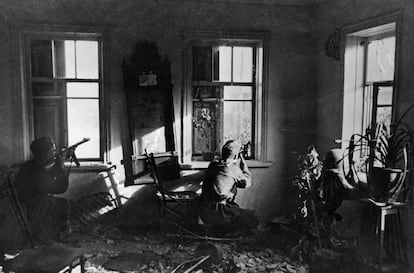The heroic resistance of a small group of soldiers against a vastly superior enemy has been part of military history since the dawn of Western culture.
“To the Greeks who were at Thermopylae, the first one who announced that they were going to die at daybreak was the seer Megistias”, writes Herodotus in volume VII of his
History
of him.
However, despite the bad omens, Leonidas and his 300 Spartans decided to fight to the end against the Persians in that gorge.
Herodotus assures that they were characters "worthy of being remembered" and that he managed to find out the names of each one of those 300.
Since then, military history has offered numerous examples of this desperate resistance, sometimes of defeats turned into myths, others of victories against all odds after impossible endurance, from the Alamo to the Alcázar of Toledo during the Spanish Civil War;
the Siege of Bastogne, during the Battle of the Bulge at the end of World War II;
or the last of the Philippines.
This detachment of Spanish hunters withstood the attack of a much larger force for 11 months before surrendering with full honors and became an imperial myth that sought to make people forget that it was a losing war.
The hundreds of Ukrainian fighters who resist in the Azovstal steel mill, among the ruins of Mariupol, the city besieged by Russia for more than 50 days,
More information
Follow the last hour of the war live
“The conquest of Mariupol has taken on enormous symbolic importance,” British military historian Antony Beevor explains by email.
“What I would like to know is if the defenders are really Russian speakers or Ukrainians.
The fact that Mariupol is mostly Russian-speaking, supposedly the same people that Vladimir Putin wants to rescue with his armies from Ukrainian Nazism, and that they resist so desperately, is something that the Kremlin cannot admit.
Image of a bombing against the Azovstal plant obtained by a drone and released on Tuesday by the Mariupol City Council. MARIUPOL CITY COUNCIL (via REUTERS)
But, beyond their symbolic value, these entrenchments have a military meaning.
The case of Mariupol, a city in southeastern Ukraine and the main port on the Sea of Azov, flattened by Russian bombs since the beginning of the invasion, demonstrates the enormous difficulties that urban combat poses for the assailants, much more than for the defenders, who can use the ruins to set up ambushes and hold off the enemy's advance for days, all without counting on the powerful propaganda value provided by such heroic resistances.
This was what happened during the Battle of Stalingrad, the Soviet victory after a long siege that sealed Hitler's defeat in World War II in 1943, where there were also long assaults on factories in a city of which only ruins and debris.
A single sniper could wreak havoc on a far superior enemy.
In his account of that battle, Beevor recalls Zaitsev, "a taciturn shepherd from the Urals," who felled 149 Germans.
"News of his exploits spread throughout the front," he writes.
Tor Bukkvoll, Senior Researcher at the Norwegian Defense Research Establishment (FFI), an expert on Russia and Ukraine, explains: “He has an essential strategic point of view.
Not only because Russia needs to control Mariupol to seize that strip of southern Ukraine to link Crimea with Donbas.
It is also important because it forces the attackers to keep a very significant number of troops on the ground, which Moscow would need elsewhere.
Furthermore, Mariupol's resistance has shown Russian leaders how difficult it is to take a city when it is well defended.
I believe that what happened in Mariupol, which had 450,000 inhabitants before the war, has been decisive for Moscow to give up trying to take kyiv, which has almost three million inhabitants”.
Soviet snipers shoot at the enemy from a house in the Battle of Stalingrad, during World War II.
Sovfoto (Universal Images Group via Getty)
There is little certainty about what happens at the Azovstal steelworks because Ukraine does not provide data for obvious security reasons.
It is a huge complex of buildings, about 11 square kilometers, in which they can resist between 2,500 soldiers —according to the Russian Ministry of Defense— and between 500 and 800, according to other estimates.
Justin Crump, a military expert at the Sibylline consultancy, explained to the British BBC that the industrial plant "has nuclear bunkers and tunnels that can withstand bombing."
"It's really very well laid out for defense and they've had more than 50 days to fortify themselves and prepare escape routes."
The fact that it is such a well-defended place has made some chemical weapons experts fear that Russia may be tempted to use this type of unconventional weaponry to dislodge resistance fighters.
"The threat of chemical weapons is real," Russian military strategy expert Katarzyna Zysk told France 24.
"At this time, it makes military sense for Russia to achieve victory in Mariupol as soon as possible, because that would free up many forces for its planned offensive in the Donetsk area," the chemical weapons expert and former chief told the same network. from the laboratory of the Organization for the Prohibition of Chemical Weapons (OPCW) Marc-Michael Blum, who explained that a small-scale attack, without witnesses, in an isolated area of Mariupol, would be very difficult to prove.
Kurz Allison's engraving of the Battle of Quasnimas in the Philippines in 1898. Photo 12 (Universal Images Group via Getty)
On the possibility of trying to isolate the contingent that is resisting in the steel mill, entrenched along with an undetermined number of civilians who had sought refuge from Russian bombing in the factory, Beevor believes that Moscow troops "could surround them until they died of starvation." ”.
Bukkvoll argues instead that this strategy poses a problem, because leaving an enemy behind can always provoke guerrilla attacks from the rear.
This expert also believes that the refusal to surrender is also influenced by the fact that, during the war for Donbas that started in 2014, on other occasions the Ukrainian soldiers who had surrendered their weapons were also bombed when leaving their positions.
“There are hundreds of places related to heroic resistance throughout history.
The entire War of Spanish Independence is plagued by this type of site”, explains the military expert from the Elcano Royal Institute Félix Arteaga.
“In some cases, they could have a very important meaning and decide the course of a war.
The epic is given by the time during which it resists and also when the position is maintained despite the fact that everything is already decided, as happened with the last of the Philippines.
What happens in the Mariupol steelworks is not going to decide the meaning of the war, but it gives an epic meaning to their resistance”.
Follow all the international information on
and
, or in
our weekly newsletter
.
Exclusive content for subscribers
read without limits
subscribe
I'm already a subscriber





